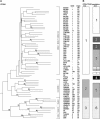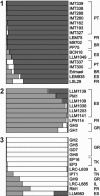Multilocus microsatellite typing as a new tool for discrimination of Leishmania infantum MON-1 strains
- PMID: 16455904
- PMCID: PMC1392658
- DOI: 10.1128/JCM.44.2.495-503.2006
Multilocus microsatellite typing as a new tool for discrimination of Leishmania infantum MON-1 strains
Abstract
The Leishmania donovani complex, which consists of L. donovani, L. infantum-L. chagasi, and L. archibaldi, is responsible for visceral manifestations of leishmaniasis. Multilocus enzyme electrophoresis is the standard method for the characterization and identification of strains of Leishmania. For L. infantum, the predominance of zymodeme MON-1 significantly reduces the discriminative power of this approach. In the present study, we developed 17 independent polymorphic microsatellite markers for the typing of strains of L. infantum, with the main emphasis on zymodeme MON-1. The discriminative powers of 11 markers selected from among these markers were tested by using a panel of 63 isolates of the L. donovani complex. Unique multilocus genotypes were observed for the strains analyzed, with only three exceptions. Model-based and distance-based analyses of the data set showed comparable results. It was possible to discriminate between L. donovani sensu stricto, a non-MON-1 group of L. infantum isolates, and a MON-1 group of L. infantum isolates. Within MON-1, three clusters with geographical correlations became apparent. The frequency of heterozygosity in the alleles analyzed varied extremely between the different groups of isolates. The main clusters described are not consistent with species definitions based on isoenzyme analysis but confirm the results of former PCR-based investigations.
Figures



References
-
- Andresen, K., M. E. Ibrahim, T. G. Theander, and A. Kharazmi. 1996. Random amplified polymorphic DNA for the differentiation of Leishmania donovani isolates from Sudan. Trans. R. Soc. Trop. Med. Hyg. 90:204-205. - PubMed
-
- Ashford, R. W. 2000. The leishmaniases as emerging and reemerging zoonoses. Int. J. Parasitol. 30:1269-1281. - PubMed
-
- Bloor, P. A., F. S. Barker, P. C. Watts, H. A. Noyes, and S. J. Kemp. 2001. Microsatellite libraries by enrichment, v 1, September. [Online.] http://www.liv.ac.uk/∼kempsj/genomics.html. Accessed January 2002.
-
- Bowcock, A. M., A. Ruíz-Linares, J. Tomfohrde, E. K. Minch, J. R. Kidd, and L. L. Cavalli-Sforza. 1994. High resolution human evolutionary trees with polymorphic microsatellites. Nature 368:455-457. - PubMed
Publication types
MeSH terms
Substances
Associated data
- Actions
- Actions
- Actions
- Actions
- Actions
- Actions
- Actions
- Actions
- Actions
- Actions
- Actions
- Actions
- Actions
- Actions
LinkOut - more resources
Full Text Sources

